Posted by Vincent Keers on 09-25-2002 10:44 AM:
Heavy stuff
Dear Fred,
Thanks for the salon.
Here's a face that says
it all:
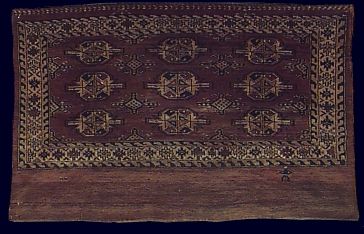

If you look at the legs, the O shape, this is
a heavy weight Turkman Cowboy.
The girl that made this didn't do a very good
job, but whatever, she knew what her man should look like.
Notice the nice belt, white hat and
white swinging shoes!
There...that's my baby
Best
regards,
Vincent
Posted by R. John Howe on 09-25-2002 07:53
PM:
Not Such “Heavy Hitters”
Dear folks –
This example seems to go with Vincent’s
above, and may an instance of what statisticians might call “regression to
the mean.”
The is a gabbeh rug in Jim Opie’s other book,
“Tribal Rugs,” Plates 10.11 and 10.12.
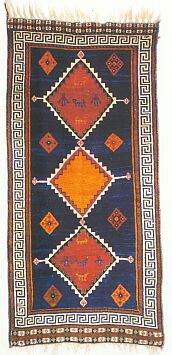
In both the top and the bottom diamonds there are
human figures.
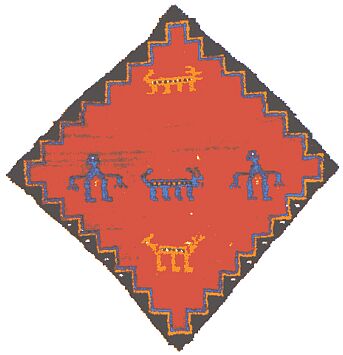
Although it’s hard to tell in my scan
here, these figures seem male since there are traces of penises in the book
image that don’t come through fully here.

The
penises are not even really fully visible here in this close-up (my scanner
reacted to this image and translated it somewhat and dropped out the white
lines and dots that are used to draw the penises and
testicles).
Here’s what, with magnification, the drawing looks like
in the book schematically: ‘|’
Now, these guys can’t
compete with Vincent’s Turkmen, but this is an example of an explicit
sexual image in a South Persian rug.
Regards,
R. John Howe
Posted by Fred_Mushkat on 09-26-2002 05:33 AM:
Hi Vincent,
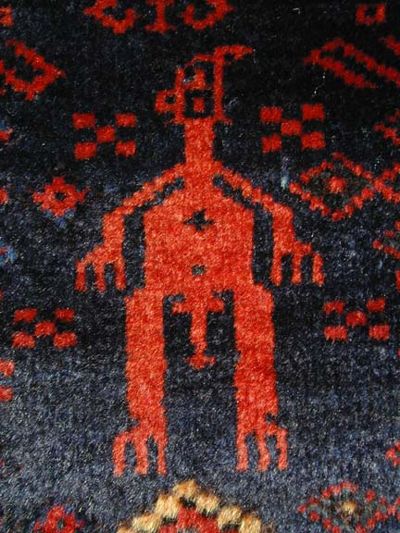
Some time ago, I posted this image
from a Balouch rug. I have seen similar images on rugs as mundane as a Hamadan
runner. The abundance of these images in tribal art reinforces the idea that
these items are found with greater frequency on nomadic textiles, and in
decreasing numbers on village, city, and court
textiles.
Regards,
Fred Mushkat
Posted by Yon Bard on
09-26-2002 09:02 AM:
Perhaps many of these images are just naive attempts at 'anatomic
correctness' and have nothing to do with sex or reproduction? After all, giving
people legs is not indicative of walking, etc.
Regards, Yon
Posted by Steve Price on 09-26-2002 09:25 AM:
Hi Yon,
Your point is right on the money. Equating display of
certain body parts with sexual suggestivity is culture specific, and many
cultures don't find depictions (or, for that matter, live display) of penises,
female breasts, and such to be titillating or even particularly interesting. At
the other end of the spectrum, some forbid display of any part of a woman
except her eyes.
The fact that titillating stimuli differ so widely
among cultures seems to me to bear on the thesis that "beauty" has a hardwired,
innate basis. If sexual stimulation by visual images doesn't (and I think it's
difficult to explain the cultural variability any other way), it places real
limits on the likelihood that less significant visual stimuli do have hardwired
meanings. There aren't many things more important, evolutionarily speaking,
than reproductive matters.
Regards,
Steve Price
Posted by R. John Howe on 09-26-2002 08:20 PM:
Yon, Steve -
"Sex" is, likely many others, an ambiguous word. It
is used to indicate that a person's or animal's sex is being identified and it
can be used to point to sexual behavior.
I think we've actually been
fairly careful so far to indicate that the "sexual" character of the images we
have been putting up are (excepting in the case of the horses' erections), is
that the genitals and other indicators shown (e.g., skirts) are instances in
which the central issue is whether the figures are male or female, not whether
they are engaging in sexual behavior.
Regards,
R. John Howe
Posted by Chuck Wagner on 09-27-2002 10:34 AM:
Greetings all,
I'll offer up this peculiar Qashqai rug as a
possible example of what Yon suggested, a nod toward anatomical correctness.
The genetalia are not highlighted in any way and, in fact, are overwhelmed by
the imagery of a polka-dotted lion. But his "Occams razor" argument has a ring
of correctness to it.
On the other hand, maybe the presence of genetalia
in eastern weavings is an inside joke on the part of the weavers, getting even
with husbands for not paying attention when asked: "Do you like my new design
?" Sort of an ad-hoc Ya-Ya Sisterhood of the
Dasht-i-Kavir...
Regards,
Chuck
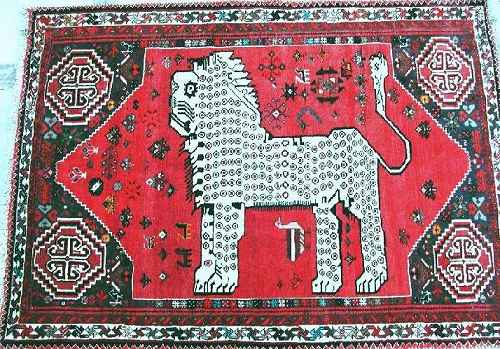
__________________
Chuck Wagner
Posted by Fred Mushkat on 09-28-2002 10:40 PM:
Hi all,
I completely agree with Steve and a number of others on
these threads that there is a huge difference between depicting sexual
characteristics to identify the sex of the figure, and depicting any sexual or
reproductive act. For example, in the salon, the people in figures 9 & 10
are part of a series of 4 people, 3 males and a female. It is my conjecture
that the number and sexes of the four images represent some sort of family unit
in which there were 3 men and a woman. Perhaps there were two sons and their
parents. The weaver chose to use breasts and penises to portray this family
unit, and in my opinion, there is no sexual content to the group of figure.
On the other hand it is considerably more rare to find images like
figure 1, which, in my opinion, allude to the act of intercourse. In all
fairness, this may be yet another family unit, but the placement of the figures
and the fact that a similar image has also been identified on another band
strongly suggests sexual content, and not just identification of a man and a
woman.
Regards,
Fred Mushkat







